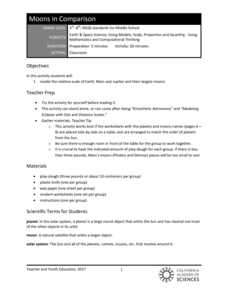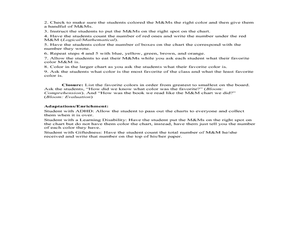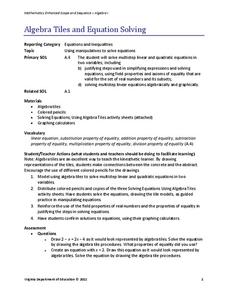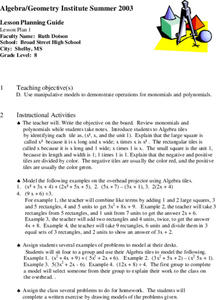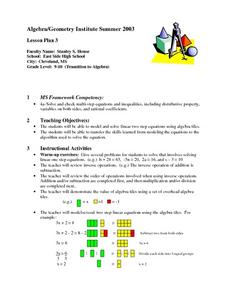Curated OER
Numbers You Can Count On
Pupils engage in a lesson that is concerned with the concept of recognizing numbers. They use Crayola Coils to imitate a number that is made from a ball. The activity is especially suitable for students who are kinesthetic.
Alabama Learning Exchange
Exponents and Division
Create a human fraction to learn about division of exponents. Scholars develop the rule for division of exponents by being part of a human fraction to explore and justify the rule. They also consider zero exponents and negative exponents.
California Academy of Science
Moons in Comparison
Just how big is Earth's moon? With a hands-on simulation, scholars use Play-Doh to model the sizes of the planets Earth, Mars, Jupiter, and their moons. They make predictions as a class, work together to make their models, and discuss...
Curated OER
Dolphins And Penguins
Students participate in an activity that reinforces vertical addition sentences as well as provides facts about penguins. They assess a kinesthetic/visual activity to reinforce the difference between vertical and horizontal addition...
Beyond Benign
Decision Graphic Introduction
E is for economics, environment, and social equity. The fifth installment of a 15-part series has scholars first considering ecological impacts, such as determining how much water it takes to produce a can of soda. They then use decision...
Curated OER
Veggie Chop and Data Analysis
First graders chop vegetables into fractions. In this fractions lesson, 1st graders cut vegetables, collect data about favorite vegetables and create a bar graph using the information. Students make inferences about the data and record...
Curated OER
M&M Counting Chart
Students practice classifying objects while utilizing candy. In this sorting lesson, students observe an assortment of M&M's and analyze the candy based on color. Students create a color chart based on the number of different colored...
Perkins School for the Blind
Volume, Mass, and Density Boxes
Mass and density are difficult topics for kids to understand, and even more difficult when you have visual impairments or blindness. Learners will make boxes and fill them with cotton, sand, or crushed paper. They will feel the density...
Virginia Department of Education
Algebra Tiles and Solving Equations
Young mathematicians solve linear equations by drawing models of algebra tiles using colored pencils. To finish, they solve the same equations algebraically and check their answers using a graphing calculator.
Curated OER
Mathematics: Technology and Connections
Sixth graders interpret and replicate patterns. In this patterns lesson, 6th graders are given an item with a definite pattern which they must replicate using a calculator or computer and then justify how they relate. Students listen to...
Curated OER
Polynomials
Eighth graders investigate the concepts and combining them into polynomials. The teacher uses direct instruction for delivery. They can use Algebra to make this lesson hands-on for the benefit of kinesthetic learners.
Curated OER
Solve and check multi-step equations and inequalities
Young scholars participate in a lesson that is concerned with the solving of multiple step equations and inequalities. The use of algebra tiles translates the information well for the kinesthetic learners. Then the skills are used to...
Curated OER
Operations For Polynomials
Eighth graders investigate how to combine polynomials using different operations. The use of tiles is done in order to accommodate those who are kinesthetic learners. The sequencing of the lesson is easy to follow.
Curated OER
Polymers and Products from Petroleum
Over four sessions, learners survey the production and use of polymers and petroleum products. First, they participate in a kinesthetic activity to demonstrate how polymers act, and review a list of common products made from polymers....
Curated OER
Self-Control
Students participate in a problem solving activity. In this conflict resolution lesson, students sit in a circle and take turns standing up, but two children cannot be standing up next to one another at the same time. Students are...
Curated OER
Finding Patterns with Frogs
Young scholars create patterns. For this math lesson, students complete and create patterns using pattern blocks or disks. Young scholars analyze the patterns they see.
Curated OER
Balance or Tilt?
Sixth graders investigate the concepts of a variable, constant, expressions, and equations. They solve problems which require the interpretation of expressions in and out of equations looking for solutions. Students also use a balance...
Nazareth College
Cooperation and Conflict Resolution
Fourth graders participate in a variety of activities designed to promote cooperation and positive conflict resolution. In cooperative groups, they create a comic strip or poster, play cooperative musical chairs, write a journal entry...
Curated OER
Transforming Triangles
Sixth graders examine how to graph translations (slides) and reflections (flips) on a coordinate plane. They practice the slides and flips kinesthetically and apply it to a worksheet working with triangles.
Curated OER
Altimetry
Fifth graders accurately measure the distance to eight points on an uneven surface by conducting a simulation of sattelite altimetry. They create a two-dimensional model of the simulated ocean surface by graphing data from the Radar Run...
Curated OER
Math Lesson Plan
First graders are introduced to how to use a ruler and its purpose. Using a boomerang, they estimate its length and then measure it using a string and ruler. In groups, they practice the same exercise with various objects while...
Curated OER
Y-Intercept and Slope Intercept Form
Alegebra amateurs identify the slope and the y-intercept given a linear equation in slope-intercept form by correctly completing some in class problems. They write the linear equation in slope-intercept form that corresponds to the given...
Curated OER
Yummy Gummy Subtraction
Here is a quick 15 minute lesson intended to introduce subtraction. Learners count and subtract gummy bears to complete 5 problems. The lessons suggest that the gummy bears can be saved and used the next day, but gummy bears get gross...
Curated OER
Dot Plots
Number crunching statisticians explore displaying data with dot plots and define the difference between quantitative data and qualitative data. Dot plots are created based on a set of given data and analyzed.




